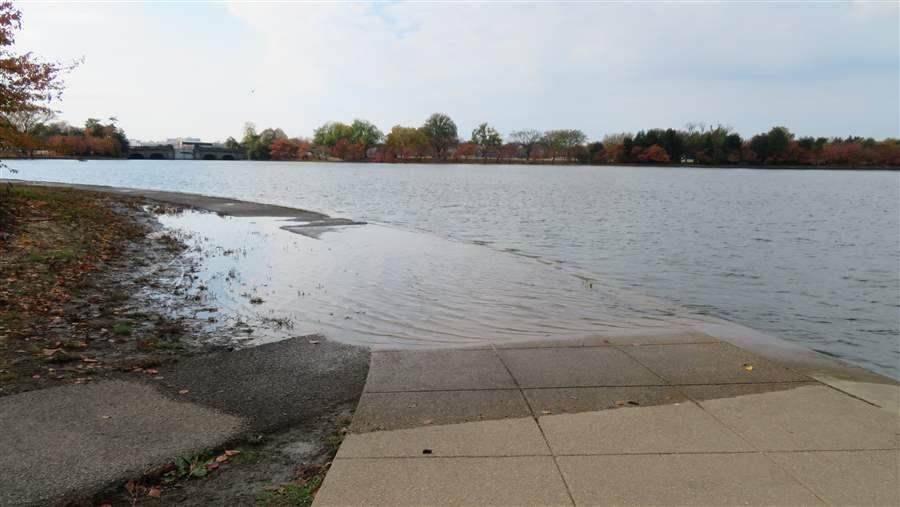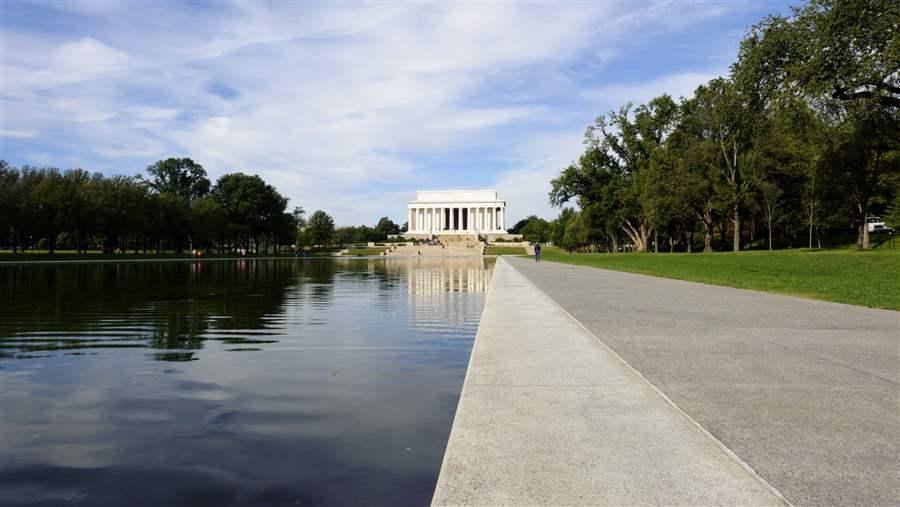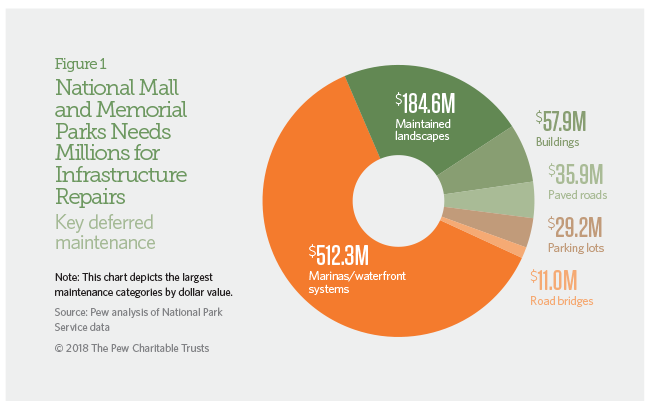National Mall and Memorial Parks
Washington, D.C.
Pew created this case study using National Park Service deferred maintenance data issued in fiscal year 2015. The information listed here may no longer reflect the NPS site’s current condition or maintenance requirements. To find the most up-to-date information, please use the National Park Repair Needs tool.
Overview
The National Mall and Memorial Parks, a unit of the National Park Service (NPS), is home to some of the nation’s most recognizable landmarks, including the Washington Monument, Lincoln Memorial, and Thomas Jefferson Memorial. Designated by Congress in 1965, these iconic sites commemorate presidents, honor the sacrifice of war veterans, and celebrate our country’s commitment to freedom and equality.
Often referred to as “America’s front yard,” the National Mall spans the area between the Potomac River and the Capitol. Beyond the Mall and memorial grounds, the Memorial Parks includes 156 small green spaces and many circles, squares, and fountains throughout Washington, DC. Ford’s Theatre, East and West Potomac Parks, Pennsylvania Avenue National Historic Site, and the new Belmont-Paul Women’s Equality National Monument are also managed as part of this NPS unit.
Unfortunately, the National Mall and Memorial Parks has the highest amount of deferred maintenance in the National Park System, at more than $840 million.

The National Mall requires $840 million in repairs, including shoring up a seawall to prevent flooding on a path to the Thomas Jefferson Memorial.
© The Pew Charitable Trusts
Pew created this case study using National Park Service deferred maintenance data issued in fiscal year 2015. The information listed here may no longer reflect the NPS site’s current condition or maintenance requirements. To find the most up-to-date information, please use the National Park Repair Needs tool.
Maintenance challenges
The most significant deferred maintenance is refurbishing of the memorials and repairs to the infrastructure that supports them. The monuments were built on what was largely swampland, without today’s sustainable design techniques. And the parks don’t have many amenities—let alone enough restrooms—to accommodate the more than 36 million visits they host each year. Key projects include repairing the roofs of the Jefferson and Lincoln memorials. Initial work to prevent pieces of the Jefferson Memorial from falling on visitors has been completed, but longer-term repairs are required. Water pipelines that serve the memorials and seawalls separating the river from the Mall grounds also need to be fixed.
A large portion of the total—over $500 million—is needed to maintain the infrastructure that surrounds East Potomac Park, a man-made island that the NPS opened to the public in 1912. A five-mile-long seawall is disintegrating; sidewalks throughout the park are often cracked and buckled; and the miniature golf course is worn and dirty. A portion of the seawall and sidewalk along the southern tip of the park is in such bad shape that the NPS closed it to pedestrians in 2014. And on West Potomac Park and the Tidal Basin, which wraps around the Jefferson Memorial, sidewalks flood so often that the NPS has created alternative pathways connecting the memorial to the parking lot.
The National Mall is home to more than 26 miles of sidewalks, 8 miles of bike trails, and 300 acres of turf1, all of which are worn down by visitors and locals. About 30,000 people use 15 softball fields, eight volleyball courts, two rugby fields, two multipurpose fields, and the Washington Monument grounds to play sports nearly year-round2. The Mall is also the setting for more than 3,800 permitted events annually3—translating to about 10 a day. This heavy use has led to a $13 million repair backlog for the Mall grounds alone.
A piece of this green vista—Constitution Gardens—needs nearly $150 million in repairs. Congress established the Gardens, located between the Washington Monument and the Lincoln Memorial, in 1976 in recognition of the bicentennial of the American Revolution. In 1984, it dedicated a memorial to the 56 signers of the Declaration of Independence on a small island in the lake. According to the Trust for the National Mall, “If you visit Constitution Gardens today, you’ll find dead fish floating atop stagnant ponds, flooded and cracked sidewalks, and weed- strewn swathes of dirt where lush lawns once grew. What you won’t find so easily are restrooms, functioning water fountains, dining options, and other basic visitor amenities.”4 Funding through public-private partnerships is being used to renovate Constitution Gardens and make it more accessible.
The accumulated deferred maintenance and sorely needed upgrades throughout the grounds preclude our ability to present the National Mall as the best park in the world... The Trust has embarked on an unprecedented partnership with the National Park Service to raise the necessary funds to complete critical upgrades on the National Mall.
There is no question of the importance and urgency of our mission.John E. “Chip” Akridge III, founder and chairman, Trust for the National Mall
National Mall and Memorial Parks Facts
2016
| Visitor spending | $34.4 million |
| Jobs created by visitor spending | 493 |
| Economic output | $48.8 million |
| Labor income | $19.4 million |
| Visits | 36,000,000 |
| Deferred maintenance (fiscal year 2015) | $840.3 million |
Sources: National Park Service, “Visitor Spending Effects,” accessed Oct. 6, 2017, https://www.nps.gov/subjects/socialscience/vse.htm; National Park Service, “NPS Deferred Maintenance Reports,” accessed Oct. 6, 2017,
https://www.nps.gov/subjects/plandesignconstruct/defermain.htm.
© 2018 The Pew Charitable Trusts
Recommendations
To address the infrastructure needs at the National Mall and Memorial Parks and other NPS sites in Washington, DC, and across the country, Congress should:
- Ensure that infrastructure initiatives include provisions to address park maintenance.
- Provide dedicated annual federal funding for national park repairs.
- Enact innovative policy reforms to ensure that deferred maintenance does not escalate.
- Provide more highway funding for NPS maintenance needs.
- Create more opportunities for public-private collaboration and donations to help restore park infrastructure.
Endnote
- National Park Service, “National Mall and Memorial Parks Little-Known Facts,” accessed Nov. 22, 2016, https://www.nps.gov/ationalmallplan/Documents/Media/NAMA Fact Sheet.pdf.
- Ibid.
- Ibid.
- Trust for the National Mall, “Constitution Gardens: An Oasis in the Nation’s Capital,” accessed Dec. 1, 2016, http://nationalmall.org/explore-national-mall/monuments-memorials/constitution-gardens.
The Pew Charitable Trusts works alongside the National Parks Conservation Association, the National Trust for Historic Preservation, and other national and local groups to ensure that our national park resources are maintained and protected for future generations to enjoy.


National Park Deferred Maintenance Needs


Funding is Overdue for National Park Repairs

National Park Maintenance Needs Take Center Stage











